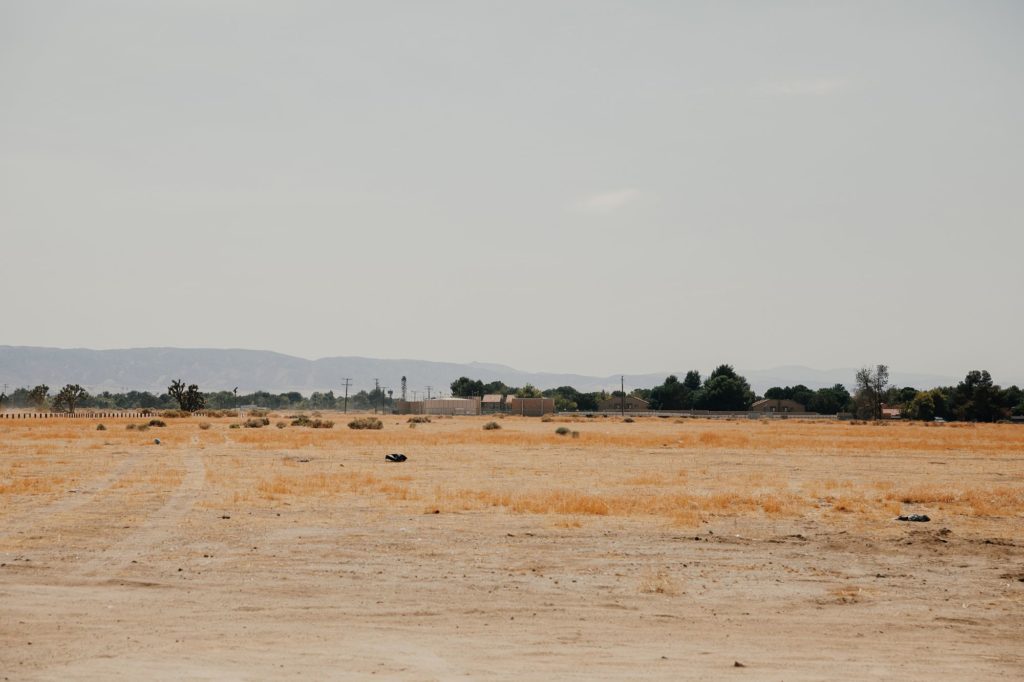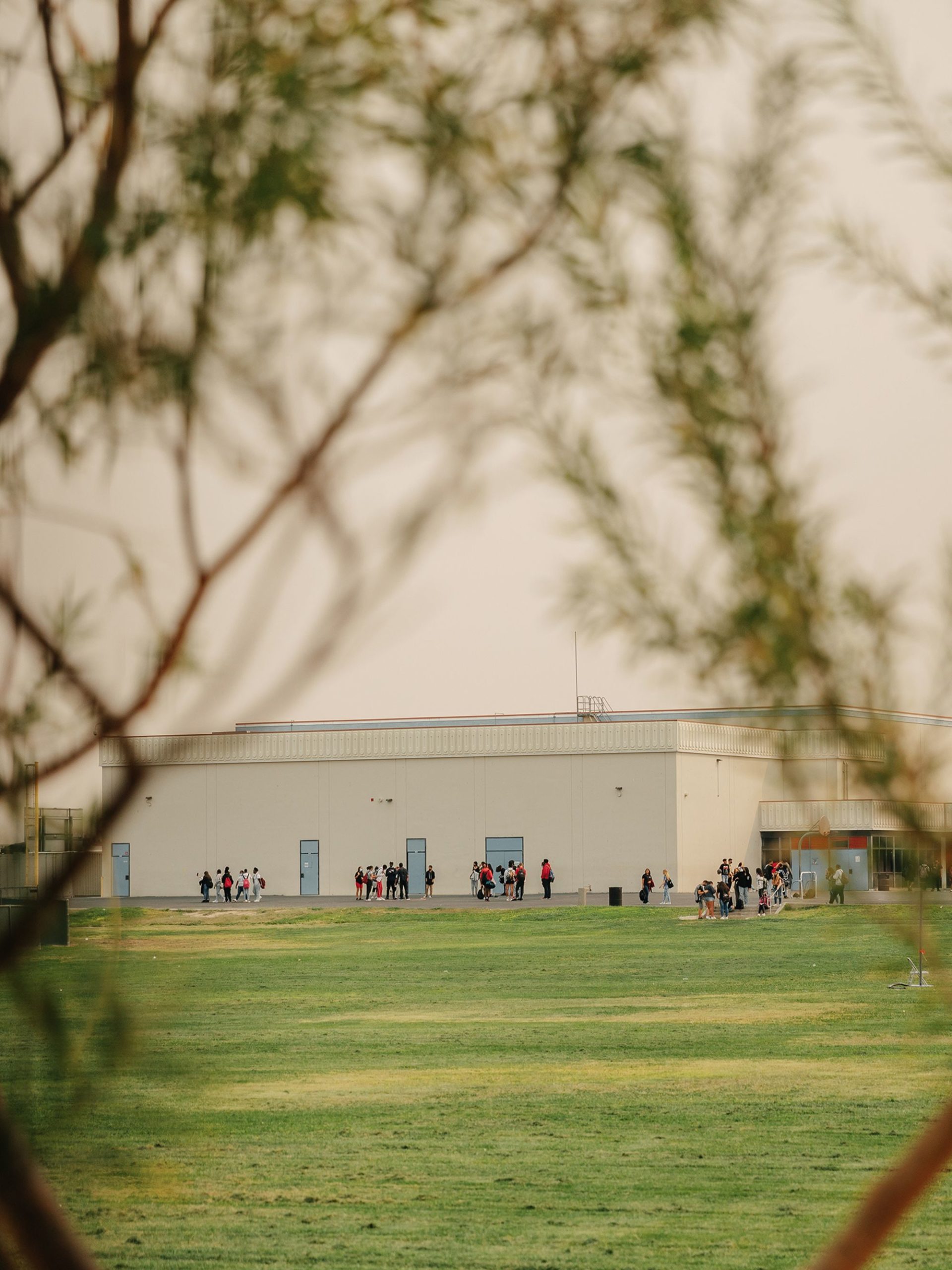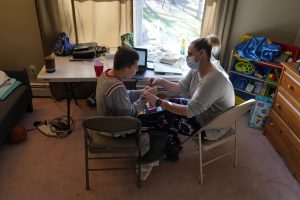Deputies in California’s Antelope Valley are disproportionately citing Black teens, often for minor infractions, like getting in fights or smoking. “They’re turning the principal’s office into the police station,” said one lawyer.
This article was produced for ProPublica’s Local Reporting Network in partnership with KPCC and LAist.
ProPublica is a nonprofit newsroom that investigates abuses of power. Sign up for Dispatches, a newsletter that spotlights wrongdoing around the country, to receive our stories in your inbox every week.
LANCASTER, Calif. — Barron Gardner, a high school history teacher in Southern California’s Antelope Valley, stared down Los Angeles County Sheriff’s Department deputies during an online meeting in April, trying to keep his composure.
Gardner, 41, had become a reluctant spokesperson for a growing movement, driven primarily by Black and Latino residents, to get LASD deputies off school campuses. His wife, who’s also a teacher, worried about the repercussions for their family. What if he lost his job? What if he became a target of discrimination or worse? After all, this valley at the western edge of the Mojave Desert, population roughly 500,000, has a long history of racial tension, including white supremacist attacks on Black community members.
But Gardner felt obligated to speak up during the meeting, which had been called by school district administrators. Some of his Black students had complained that they were treated differently than white kids caught doing the same things, like fighting, disrupting class or smoking cigarettes. He’d been concerned for a long time about the culture on campus, fearing it encouraged staff to turn Black students over to law enforcement. But Gardner knew he needed more than just a hunch and secondhand accounts, he said.
He also knew the LASD had a well-documented, troubled track record in the Antelope Valley. In 2013, a Department of Justice investigation found that LASD deputies there had violated the Constitution, including by conducting discriminatory and illegal searches and seizures primarily affecting Black residents. The investigation resulted in a settlement agreement that mandated a batch of reforms, as well as periodic monitoring reports. Gardner combed through the latest of those reports, from the summer and fall of 2020, in preparation for the meeting. Black people, he read, were still much more likely to be stopped and more likely to be searched.
He came prepared for the online meeting with the findings from the federal reports. “I went in, boom, and blew the whole thing up,” he said. But as he stared at the deputies through his screen, he felt intimidated, he said, and his voice shook. When Gardner finished, he said he was met with blank stares. “These people look[ed] at me like I was an alien from outer space,” he said.
Just because it’s happening on the streets doesn’t mean it has anything to do with the schools, Gardner recalls one district official saying. Both the Sheriff’s Department and the district have repeatedly claimed that no one is racially profiling students.
But according to data that California law enforcement agencies are required to publish under the terms of a law aimed at combatting racial profiling, Gardner was onto something: Sheriff’s deputies in the Antelope Valley have disproportionately detained and issued citations to Black teens on public school campuses, an analysis by KPCC/LAist and ProPublica found.
We analyzed and mapped thousands of contacts between deputies and civilians that took place during the 2019 calendar year, the most recent year not disrupted by the COVID-19 pandemic. The analysis focused on Lancaster, one of two major cities in the region, finding clusters of stops on public school campuses. In the vast majority of those contacts, deputies cited “reasonable suspicion of criminal activity” as the reason for the stops.
Our analysis found that during that time, six public high schools accounted for about 300 of the city’s 4,000 stops — or roughly 7 percent. When we compared the race of teens stopped with the demographics of those schools, the disparity was clear. Black teenagers accounted for 60 percent of the deputy contacts on campuses but made up only about 20 percent of the enrollment in those schools.
The highest number of the contacts — more than 100, in a student body of roughly 1,650 — was reported at Antelope Valley High School, where Gardner teaches and most of the student body is Black or Latino. The analysis shows Black teenagers made up more than 75 percent of the reasonable suspicion contacts — about 2.5 times their share of the school’s enrollment.
While Black teenagers at Gardner’s school were questioned at far higher rates than would be expected based on the demographics of the student body, the same was not true for white and Latino teenagers. Only one reasonable suspicion contact involved a white student.
The racial disparity seen in the contacts with deputies is also evident in the district’s disciplinary data, which shows that the share of Black students who were suspended was more than three times that of white students.
At Quartz Hill High School on the city’s more affluent west side, about one-quarter of contacts with deputies involved Black teens, although Black students account for less than 10 percent of the student body.

Terrell “T.J.” Pina was a 15-year-old freshman at Quartz Hill in December 2018 when he was detained by the campus deputy in a “reasonable suspicion” stop after a fight with a white student. Pina, a special education student, told school staff that the white boy had been bullying him and calling him the N-word. Terrell was charged with felony assault and spent two weeks in juvenile detention before his first hearing, his mother, Richelle Bankhead, said.
The sheriff’s data indicates that only Pina was arrested for the fight. When asked why the other student wasn’t arrested, John Lecrivain, the Lancaster Sheriff’s Station captain who took over this year, said he could not comment on individual cases involving juveniles.
“The school district had the Sheriff’s Department snatch him up and drag him through the mud like he was a criminal,” Bankhead said.
The felony charge against Pina eventually was reduced to a misdemeanor. He was sentenced to perform community service.
Administrators at Quartz Hill and Antelope Valley High School referred questions to the district. Antelope Valley Union High School District administrators did not respond to interview requests or to a list of written questions.
Stationing law enforcement on school campuses has been controversial for decades, but the backlash has grown in cities across the country since the murder of George Floyd in Minneapolis last summer spurred a broader debate about policing and race. Since then, school districts in Denver, Seattle, and Portland, Oregon, have decided to end or scale back contracts with law enforcement. The Los Angeles Unified School District, the second-largest public school district in the country, decided in February to cut funding for campus policing by one-third.
But there have been no cuts to the police budget in the Antelope Valley Union High School District, despite protests and a petition drive that gathered more than 4,000 signatures in support of ending the district’s contract with the LASD. “These targeted attacks on vulnerable communities only pushes our students into the broken criminal justice system before they’ve had a chance to build a brighter future,” the petition read.
Protestors say LASD deputies, who are stationed on at least nine of the district’s campuses, are racially profiling students, but Sheriff’s Department officials insist that is not the case. LASD Deputy Justin Ruppert, team leader of the Lancaster station’s school safety unit, said the vast majority of deputies’ contacts on campuses are based on referrals from school staff and administrators — not initiated by law enforcement.
To assess the validity of this assertion, we interviewed 25 current and former students, teachers and staff in the Antelope Valley Union High School District. Many said the deputies, who are also known as school resource officers, were brought into relatively minor disputes and that their intervention often escalated the situation.
The news organizations’ investigation found that some students detained by deputies were accused of what some experts said were routine school disciplinary issues.
“They’re turning the principal’s office into the police station,” said Daniel Losen, director of UCLA’s Center for Civil Rights Remedies. “They’re being referred to law enforcement with the kinds of things that, once upon a time, you would just have a little detention, or meet with a principal, or a parent conference.”
Experts interviewed by KPCC/LAist and ProPublica said that a U.S. Supreme Court decision empowered police on campus by loosening Fourth Amendment protections on public school campuses, reducing the burden of proof required for school officials to conduct stops and searches. In California, courts have ruled that those lower legal standards also apply to school resource officers, giving them wider discretion to stop and search students than they would have off campus.
“The reality in California is that schools have become ‘Constitution-free’ zones,” said Richard Braucher, a staff attorney at the First District Appellate Project.
Victoria Ruffin, an Antelope Valley Union High School District board member who cast the lone vote against approving a new contract with the LASD in July, said the analysis by KPCC/LAist and ProPublica supports what she has long suspected. While reviewing expulsion and suspension cases that came before the board during the past three years, she noticed that most seemed to involve Black students. Often, she said, the descriptions of their offenses mentioned referrals to school resource officers.
“It’s a slap on the hand for this kind of kid, but [for] this kid,” there’s punishment, Ruffin said.
A Troubled History
The Antelope Valley sits more than 60 miles north of Los Angeles, up a highway that winds through the San Gabriel Mountains and opens into a vast desert dotted with Joshua trees and other yuccas. The two largest cities in the valley — Lancaster and Palmdale — grew rapidly in the past 30 years, fueled by people priced out of Los Angeles real estate. With that growth came a dramatic demographic shift. White people, who in 1990 had been strongly in the majority at 80 percent, now account for less than one-third of the population, which is mostly Latino and Black.

Lancaster Mayor R. Rex Parris, a Republican, made national news shortly after his election in 2008 for calling for a war on Section 8 housing and complaining that the city was becoming a “dumping ground” for the poor from Los Angeles. His comments led to a federal lawsuit alleging that the cities of Lancaster and Palmdale were working with the Sheriff’s Department and county housing agency to conduct sweeps of public housing, unfairly targeting Black and Latino voucher holders.
The lawsuit was dropped after the cities and Los Angeles County agreed to separate settlements, but it drew the attention of the U.S. Department of Justice’s Civil Rights Division, which, after a two-year investigation, issued a report supporting the allegations involving the housing sweeps and found that deputies routinely racially profiled Black residents in the Antelope Valley.
The DOJ and LASD entered into a court-ordered settlement agreement called a consent decree in 2015, agreeing to reforms that included protections against racial profiling. Consent decrees are one of the most powerful tools the federal government has to combat unconstitutional policing, but they often take decades to complete. The Los Angeles Police Department spent 12 years under a consent decree that was spurred by corruption in the anti-gang unit of the department’s Rampart Division, only being released in 2013. The Oakland Police Department has been under a settlement agreement for nearly 20 years.
Some consent decree monitors complained that they felt less support from the DOJ under the Trump administration, which entered into zero consent decrees and said the agreements increase crime and damage law enforcement morale.
“Prior to Trump, if you were a consent decree monitor, you could be confident that you’d be backed by the Department of Justice,” said David Douglass, the deputy consent decree monitor for the New Orleans Police Department and CEO of the nonprofit Effective Law Enforcement for All. But with Trump, “there were a lot of signs of pullback.”
In the Antelope Valley, slow progress recently prompted local residents to call for federal monitors to take LASD back to court. “We’ve lost faith in this process, to be quite frank,” said Xavier Flores, president of the Antelope Valley League of United Latin American Citizens, at a virtual town hall meeting with the federal monitoring team in February.
A review of the federal monitoring reports by KPCC/LAist and ProPublica shows LASD has made some degree of progress on nearly all of the requirements, but so far it has fully complied with only a handful, most of them related to the housing sweeps. The monitors declined interview requests.
Black people are still much more likely to be stopped and searched, the monitoring team found after analyzing all of the roughly 20,000 deputy contacts in the valley between January and July 2019. The monitors did not specifically look at activity on school campuses.
The most recent report from the monitoring team, released in early August, shows that the department still is not in compliance with the requirement that deputies have a “reasonable suspicion” to stop and detain people.
School resource officers are only mentioned in one sentence in the latest monitoring report. Monitors urged the department to “genuinely listen” to calls to cancel LASD contracts with local school districts.
Principal’s Office vs. Police Station
In Antelope Valley’s high school district, the racial disparities in the treatment of Black and white students is evident not just in the contacts with deputies on campuses, but also in the district’s own disciplinary data on suspensions and expulsions.
When a student gets in trouble, teachers can try to resolve the problem on their own, or they can call campus security or a school resource officer for help. If teachers lack the training or experience to handle difficult situations with students, they can often default to calling school resource officers, said Losen, the director of UCLA’s Center for Civil Rights Remedies. But because records involving school disciplinary hearings and juvenile court cases are typically sealed to protect student privacy, it is difficult to assess how the cases are handled across the district.
Robert Davis, who served on the Antelope Valley Union High School District board from 2015 to 2019, said he did his own informal review of outcomes of disciplinary cases that came before the board for votes on suspensions or expulsions, including some that involved deputies. He focused specifically on the racial disparities at two high schools in Lancaster: Quartz Hill and Antelope Valley High.
A former teacher and counselor with the California Department of Corrections and Rehabilitation, Davis looked for cases involving students who were accused of the same allegations and compared their punishments. His observation, he said, was that at Quartz Hill, students of color bore the brunt of any punishments handed out. White students were told not to do that again and given a second chance. At Antelope Valley High School, nonwhite students received the harshest penalties. “Bam! They were gone,” he said.
He said decisions appeared to be “fly-by-night. How are we gonna deal with this kid?”
An analysis by KPCC/LAist and ProPublica of the district’s disciplinary data shows that it disciplines students — particularly Black students — at far higher rates than the state average.
The district’s suspension rate for the 2018-19 school year was more than 8 percent, about two-thirds higher than the statewide rate for high school students, and the expulsion rate for the district was nearly 45 percent higher than the state’s.
The suspension rate for Black students is about 18 percent, meaning that about 1 in 6 Black students were suspended. That’s over three times the rate for white students, and much higher than the statewide rate for high school students.
Some teachers interviewed by KPCC/LAist and ProPublica said they fear students will face unintended consequences when teachers turn discipline cases over to deputies.
James Tilton, a teacher at Eastside High School, said that a few years back he referred a freshman who had mouthed off to him to security, thinking he’d end up in the principal’s office. The boy, who was Black, ended up in front of a deputy instead. Tilton said the deputy later told him that the boy shoved him and he arrested the student. Tilton has regretted his decision ever since, he said. He keeps thinking the boy needed teachers, counselors, psychiatrists and mentors in that moment. Instead, “we gave him a cop.”



